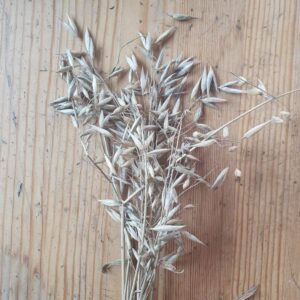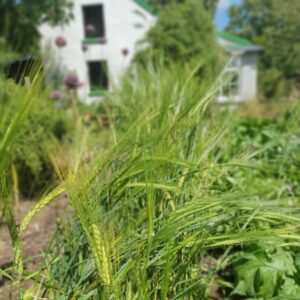Buckwheat ‘Kora’ – Irish Seed
€3.00
Buckwheat (Fagopyrum esculentum) is an annual plant that belongs to the Polygonaceae or knotweed family. As a food, buckwheat is grown for its seed which is made into gluten free flour or groats. It is the flour used for the Breton galette – a delicious savory pancake. I have not done much cooking with the groats but they are a staple in Eastern Europe and Russia. I have a Polish friend who is still traumatised from being overexposed as a child.
‘Kora’ is a variety which is noted for being resilient to spring frosts as well as drought. It ripens in about 12 weeks. I planted it a bit late this year, around mid June. I learned the hard way about the difficulty in timing the seed harvest. Buckwheat seeds ripen unevenly and they mature while the plant is still largely green. They are normally harvested when 3/4 of the seeds are brown. So some of the first seeds will be lost and a proportion will be immature. It is a small harvest window and if left too late shattering will occur and a lot of the seed will be lost. This happened to me, and alongside the awful weather at ripening time, led to a small yield.
I am still trying to figure out how to process the seeds into an edible form. Apparently they can be lightly roasted, milled and then sieved to get a flour which will have most of the hull removed.
Average 250 seeds per packet.
In stock
Growing Buckwheat as a Cover Crop
In Ireland, buckwheat is commonly grown as a green manure or cover crop. A green manure is a crop which is grown solely to improve or protect the soil, rather than as a crop to be harvested. There are many species of plants grown for this reason and many possible related benefits including building organic matter, protection from erosion, fixing nitrogen, attracting beneficial insects, improving soil structure and others. Buckwheat is a particularly good cover crop for a number of reasons:
Fast growth and weed suppressing: Buckwheat is a fast growing annual that completes its lifecycle in just 12 weeks. Bare soil can quickly become weedy once crops have been harvested. Fast growing green manures like this are great at outcompeting weeds for soil nutrients and moisture to quickly cover the ground and protect the soil.
Buckwheat has also been found to have an allelopathic effect. Allelopathy is when plants release compounds that suppress and inhibit the growth of neighbouring plants. This can be an advantage or a disadvantage. The effect will slow the take off of weeds after the crop has terminated but it can have the same effect on crops that are planted afterwards which you want to grow. Some plants seem more affected than other by allelopathy. For instance, research on green manures in Ireland has shown lettuce to be particularly sensitive to allelopathy. In any case, it is best to be sure the buckwheat crop is finished at least a few weeks before sowing the next crop to allow the effect to wear off. Buckwheat is a soft annual so winter will naturally kill it off. Otherwise it can be cut back and dug in or mulched if necessary to finish it sooner.
Neutral in crop rotations: Buckwheat is not related to any of the other food crop families so it will not conflict with any crop rotation plans.
Pollen and nectar source: Buckwheat is known as a very good food source for honey bees and produces high quality honey. It is also great for native insects. Research in the Netherlands found half the pollinators in a field of buckwheat, in which honeybee hives were introduced for pollination, were wild insects including numerous species of hoverflies, butterflies and wild bees.
Increasing Phosphorus availability: To me, the most interesting aspect of buckwheat is its purported relationship with soil phosphate. It is known as a phosphorous ‘scavenger’. Most phosphorus (P) in the soil is locked up in a mineral form which is not available to plants. Buckwheat roots exude substances which soloubilise phosphorus that is otherwise locked up in the soil. Its roots also pick this P up very efficiently and store it. When buckwheat plants are incorporated back into the soil this P and other nutrients becomes available for the following crops
Phosphorus is a non renewable resource which is mined from mineral deposits. It is guesstimated that there are enough deposits to last around 100 years. Most of it is located in 5 countries so its availability also depends on the whims of geopolitics. Most soils contain plenty of P but it is not plant available. Farming which increases soil biology, such as by using root exudates like this, will be increasingly used in the future.
Sowing Rate for Buckwheat as a Green Manure
Buckwheat can be sown as a cover crop at around 8g/m². The bulk quantities of seed required for this can be sourced elsewhere quite cheaply and is brought in from eastern Europe where it is grown on a large scale. I am growing small amounts for experimental reasons and to find and/or adapt varieties to Irish conditions for potential as a food crop.







